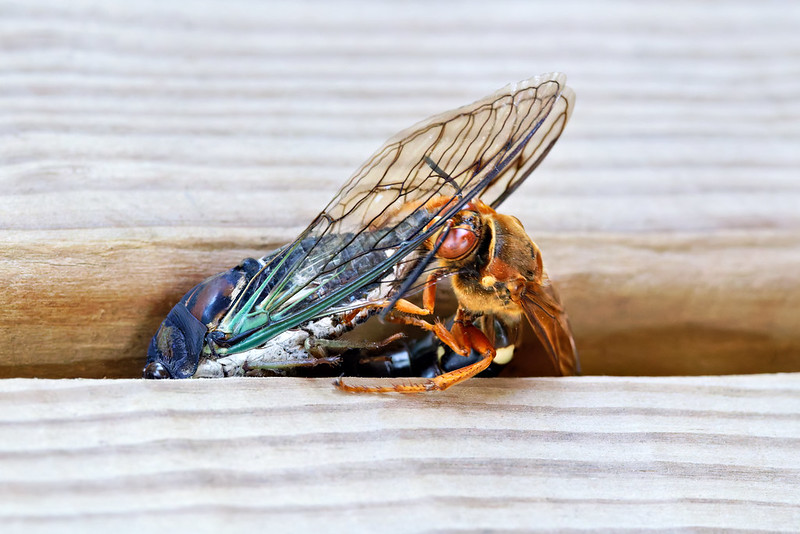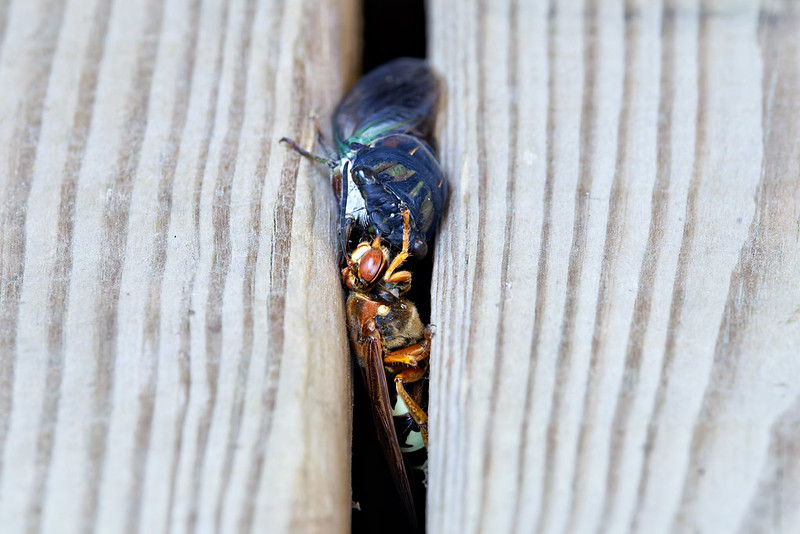Few insect encounters are as fascinating as the hunt of a cicada killer wasp (Sphecius speciosus). Recently, on my Arkansas deck, I witnessed a remarkable example of predatory wasp behavior. A female wasp was attempting to haul her paralyzed cicada prey through the narrow gaps between deck boards, a task far more challenging than it looked.

The Struggle to Deliver Prey
In the first scene, the burrowing wasp pushed and shoved a freshly captured cicada toward a chosen gap in the deck. These cicada predators are known for overpowering and paralyzing their prey before dragging them into underground chambers for their larvae to feed on. However, the cicada’s size and rigid wings made this delivery difficult. The wasp returned again and again, trying different angles in a determined effort to succeed.

A Double Challenge
Later, I saw the wasp with not one, but two cicadas. One was already wedged between the deck boards, while the other was being maneuvered beside it. Both insects remained motionless, stung into paralysis, waiting to become nourishment for the wasp’s developing young.

Nature Meets an Unyielding Obstacle
In a natural setting, cicada killer wasps dig deep burrows in sandy soil, pulling their prey inside with ease. My deck, however, presented a unique problem. The tight spacing between boards left no room for the large cicadas to pass through. Despite repeated pushing, pulling, and repositioning, the wasp simply couldn’t make the prey fit.
An Unfinished Mission
By the end of the day, both cicadas were still lying on my deck. A few days earlier, I had spotted the wasp scouting the gaps, likely searching for an entrance to a nest site. I even suspected the cicadas wouldn’t fit, and as it turns out, I was right. Even the most skilled hunters in the insect world can be thwarted by human-made obstacles.
An Unexpected Return
The next morning, my deck had a familiar visitor. The same cicada killer wasp arrived carrying yet another cicada, making this the third one in just two days. This time, I decided to give her a little help. When she was positioned underneath the cicada, tugging from below, I reached down and gently pushed the prey through the gap. With that assistance, she successfully pulled it under the deck.
Later that afternoon, I discovered a fourth cicada lodged between the boards. Unfortunately for the wasp, I wasn’t around to assist, and the prey remained stuck like the others from the previous day.
Takeaway
The cicada killer wasp is one of North America’s most powerful insect hunters. Yet, this moment on my deck shows that even perfect adaptations have limits when faced with unfamiliar challenges. You can read more about their behavior in my previous cicada killer wasp encounter from last summer.
